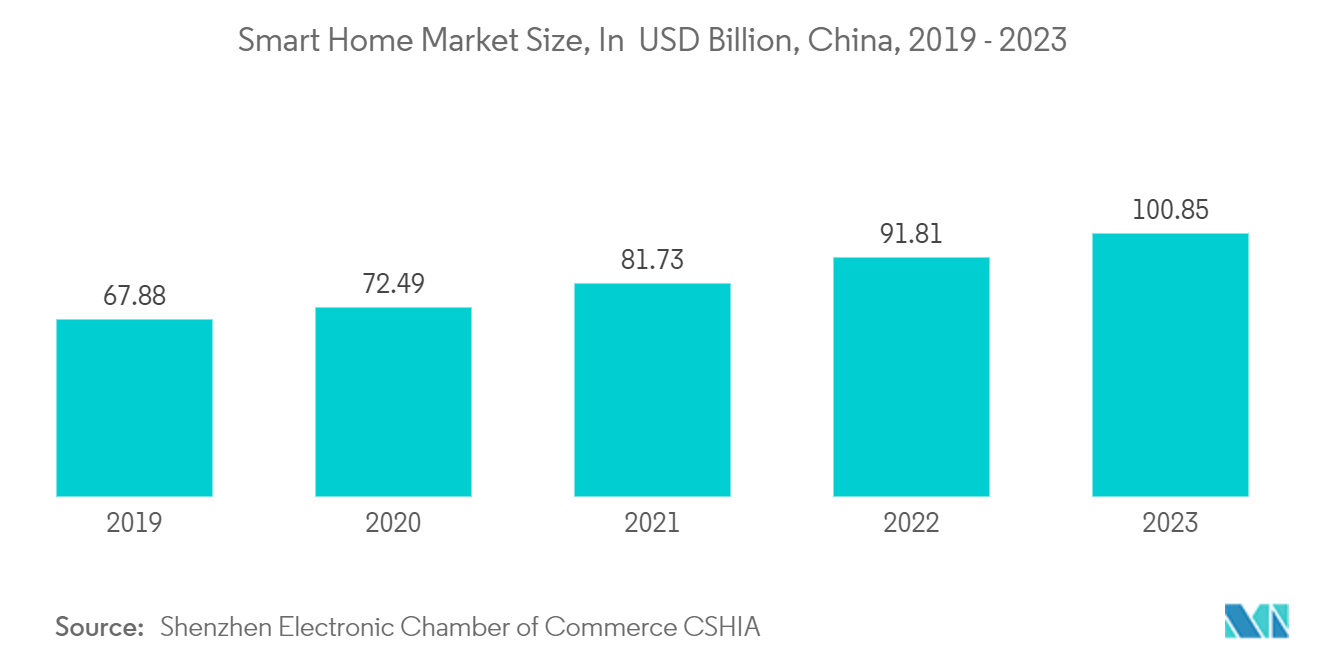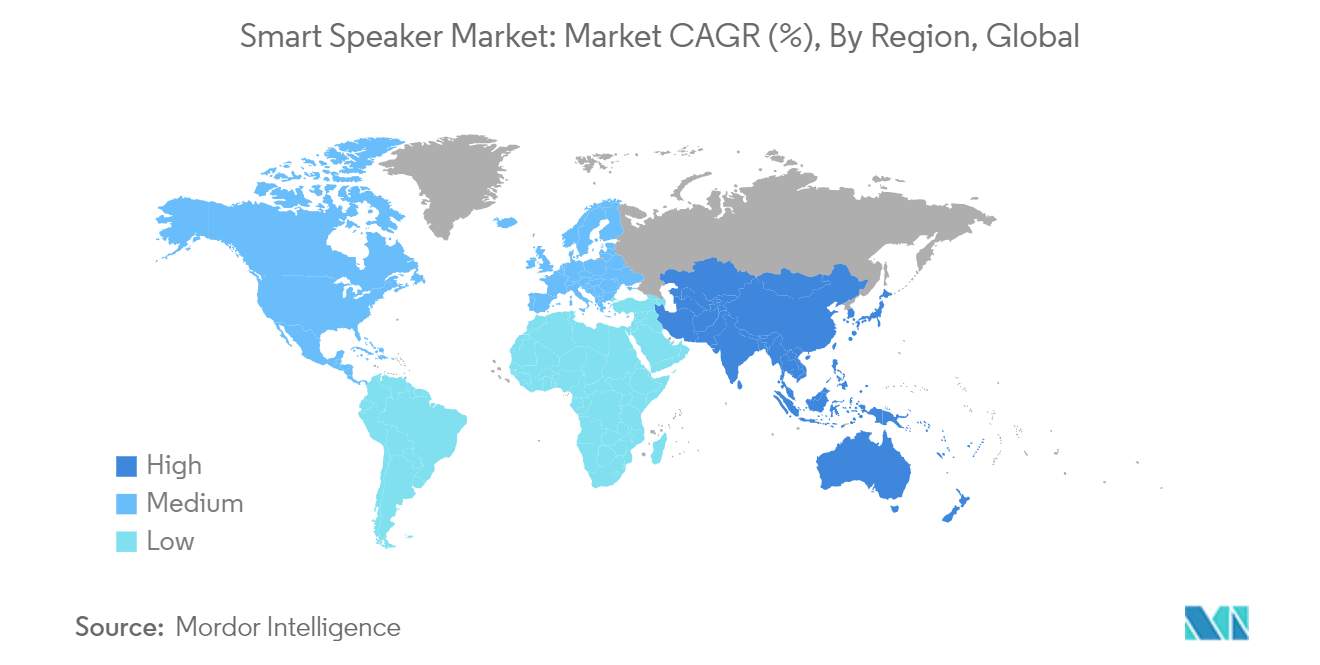Market Trends of Smart Speaker Industry
Amazon Alexa is Expected to Witness Significant Growth Rate
- Amazon offers the Amazon Echo device powered by the virtual assistant Alexa. The Amazon Alexa division is forecasted to dominate the market share in the coming years. Its adoption is rapidly increasing in various regions, particularly among US consumers, due to its first-mover advantage. This adoption is expected to grow in the next few years because of Alexa's integration with multiple smart home devices and Amazon's strategy to collaborate with emerging players in the market. The increasing demand for these devices in other regions is also expected to drive the market’s growth.
- The latest version of the original smart speaker, the Echo (4th Gen), offers all Alexa functions except those limited to smart displays like recipes. Despite its small size and reasonable price, this fourth-generation Echo delivers remarkable sound quality. It features a more direct driver design for improved audio output compared to previous models. Additionally, Dolby processing enhances the stereo effect from a single speaker, replacing the 360-degree audio design of older models. Another standout feature is its ability to dynamically equalize sound based on ambient room conditions, a function known as automatic room adaptation.
- Amazon is currently enhancing the capabilities of Alexa by utilizing generative AI technology. The company has integrated generative AI into Alexa to improve its smart home management system. By leveraging advanced large language models (LLM), Amazon aims to enhance communication with users, predict their needs more effectively, and simplify the control and automation of smart home devices. Furthermore, the implementation of generative AI has allowed Amazon to upgrade its text-to-speech technology, utilizing a large transformer model to make Alexa more expressive and responsive to conversational cues. Such technological advancements to boost the capabilities of Amazon Alexa are expected to drive the segment's growth.
- During its annual devices showcase in September 2023, Amazon unveiled new hardware and software incorporating advanced artificial intelligence capabilities. One notable improvement is the enhanced voice of the new Alexa, which will sound more human-like. Moreover, Alexa will be able to engage in more natural conversations without requiring a wake word to be prompted. Similar to applications like ChatGPT, Alexa will also be capable of composing messages on behalf of users and sending them. These advancements in Amazon Alexa are anticipated to be crucial in driving substantial growth within this segment.
- The segment's growth is anticipated to be driven by the rising adoption of Amazon Alexa in smart homes across different regions, such as the United States. Amazon provides various development options that enable users to connect their smart home devices with Alexa. In addition to managing lights and devices, Alexa's functionalities within smart homes go beyond that. It can transform the house into a central entertainment hub by linking the user's smart TV, streaming devices, and sound system to an Alexa-enabled device. This allows consumers to control all of these devices using voice commands effortlessly.
- The increasing investments in smart homes and the government's efforts to drive the adoption of smart home technology are further expected to drive the market's growth. For example, the European Union (EU) actively advocates for smart buildings to enhance energy efficiency, decrease greenhouse gas emissions, and develop sustainable urban areas.
- Likewise, the Dubai government is encouraging smart home adoption through initiatives like The Smart Dubai initiative, encouraging residents and developers to invest in innovation. Such developments are expected to boost the utilization of Amazon Alexa smart speakers due to their diverse functionalities. Furthermore, the growing demand for smart home technology across regions like China, India, Japan, and others is significantly expected to enhance the market opportunities.
- In February 2024, Amazon shared insightful data regarding using its Alexa-powered devices in India as it marked its sixth anniversary. The company revealed that its Alexa smart speakers and Fire TV Stick have been bought by customers in 99% of India's postal codes, spanning from urban areas to rural communities. This increased customer engagement has led to a 200% increase in the utilization of smart home devices connected to Alexa over the last three years. Within Indian smart homes, Alexa is utilized to manage various smart home appliances like smart lights, plugs, fans, TVs, security cameras, ACs, water heaters, and air purifiers.

Asia-Pacific is Expected to Witness Fastest Growth
- The smart speaker market in Asia-Pacific is projected to experience substantial growth due to the rising demand for Internet-of-Things (IoT)-enabled services and wireless devices. In APAC countries, such as China, India, Japan, Korea, and others, consumers’ preference for convenience goods is growing, contributing to the expansion of the market studied in the region. The region is emerging as a critical adopter of IoT technology, and the willingness of consumers to embrace new technologies has motivated manufacturers to innovate and introduce advanced products.
- The growth in investments in smart homes, the growing demand for wireless connectivity in the region, and the surge in IoT applications are propelling the smart speaker market. China, in particular, is making significant investments in smart home technology, boosting the adoption of voice assistant devices like smart speakers. According to the Shenzhen Electronic Chamber of Commerce (CSHIA), the smart home market in China surpassed CNY 652 billion (USD 89.85 billion) in 2022 and reached CNY 715.71 billion (USD 98.63 billion) in 2023. With the advancement of 5G infrastructure and a high mobile phone penetration rate, numerous Chinese electronics and home appliance manufacturers have introduced smart home systems.
- China's booming economy and remarkable technological progress have been instrumental in the exponential expansion of smart cities. Consequently, urban infrastructure has become more interconnected and efficient, significantly enhancing its inhabitants' quality of life and work. The increasing consumer expectations for comfortable, healthy, safe, convenient, and efficient lifestyles have further stimulated the widespread adoption of smart homes. As the acceptance of smart homes continues to grow, the smart speaker industry is poised to experience a surge in demand in the coming years.
- Countries such as India, Japan, and South Korea in Asia have embraced smart speakers due to their convenience and portability. The rise in consumer electronics manufacturing and the surge in wireless connectivity demand are projected to be key drivers of the market's growth in the region. Smart speakers equipped with native language support hold great promise for growth in technologically progressive regions like APAC. Leading companies like Google, Amazon Alexa, and Apple Siri are solidifying their market presence in these countries through product releases and investments.
- Google Assistant, Alexa, and Siri have succeeded significantly in Asia, but local alternatives could soon gain more popularity. This is partly due to the delayed efforts of American tech companies in incorporating Asian languages into their voice assistant and smart speaker devices. Nevertheless, there is anticipated to be a notable increase in demand for these speakers in the region. This trend is particularly evident as Asian consumers are increasingly at ease integrating voice assistants into their daily routines, especially amidst the push toward touchless technology driven by the COVID-19 pandemic.
- In August of 2023, Amazon's e-commerce platform reported a 21% rise in the utilization of multilingual mode on Alexa-enabled devices in India during 2022. According to the company, nearly half of Echo smart speaker users opt for the Indian-English/Hindi multilingual mode when engaging with Alexa. It was also disclosed that Indian users are keen to learn about Alexa's preferences, dislikes, and personal interests in relevant subjects. These insights into consumer preferences will be crucial in propelling further developments in the smart speaker market sector.
- Furthermore, in February 2023, Amazon announced that Indian users can now choose between a male and female voice for Alexa. This new feature allows Indian users to switch to a male voice instead of the current female voice. This enhancement offers users more options and freedom in their interactions with Alexa. Such significant advancements by industry players are expected to influence the market's growth potential in the region.


